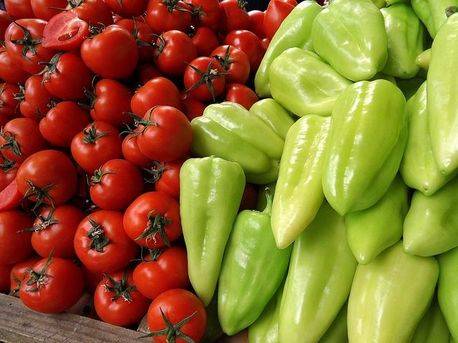Content
Lecho is the national Hungarian dish. There it is often served hot and cooked with the addition of smoked meats. And of course, vegetable lecho is prepared for the winter. Its main component is bell pepper in combination with tomatoes. There are a lot of options with various additives. Russian housewives also happily prepare these canned foods for the winter, using numerous lecho recipes.
Lecho is also prepared in Bulgaria. This country is famous for its tomatoes and peppers. Apart from them, the composition of Bulgarian lecho includes only salt and sugar. Despite the small number of ingredients, the preparation turns out very tasty and is the first to be sold in winter. Let's look at the step-by-step cooking recipe pepper lecho in Bulgarian with photo.
Bulgarian lecho
Choose the ripest and sweetest tomatoes for its preparation. It is better to take red and green peppers in a ratio of 3 to 1. You can also take fruits of different colors, then the canned food will turn out elegant.
To prepare you will need:
- sweet pepper – 2 kg;
- tomatoes – 2.5 kg;
- salt – 25 g;
- sugar – 150g.
Step-by-step preparation of Bulgarian lecho:
- Vegetables are washed. The seeds are removed from peppers, and the place where the stalk is attached is cut out from tomatoes.
- Chop the vegetables. We cut small tomatoes into quarters, larger tomatoes into smaller pieces.
- We cut the peppers lengthwise into quarters, and cut each part into longitudinal strips.
The pepper pieces should not be small, otherwise they will lose their shape when cooked. - We pass the tomatoes through a meat grinder.
- Place chopped peppers, salt and sugar in a saucepan with tomato puree. Bring everything to a boil.
- Boil the lecho for 10 minutes. The fire should be small. The thick vegetable mixture needs to be stirred frequently.
- Preparing dishes for canning. We wash and sterilize the jars and lids well, put the jars in the oven, and boil the lids. At a temperature of 150 degrees, keep the dishes in the oven for 10 minutes.
Do not place wet jars in the oven as they may burst.
Boil the lids for 10-15 minutes. - We pack the lecho into hot jars and, covering it with a lid, place it in a water bath for sterilization.
The temperature of the water in the pan where the jars are placed should be the same as the temperature of their contents. Half-liter jars are sterilized for half an hour, and liter jars for 40 minutes.
You can do without sterilization, but then the lecho cooking time needs to be increased to 25-30 minutes. If the tomatoes are very sweet, you will have to add 2 tbsp to the vegetable mixture. spoons 9% vinegar. - We seal the jars hermetically.
Pepper lecho is prepared.
There are many recipes for lecho made from bell peppers, with the addition of various products: onions, carrots, garlic, zucchini, vegetable oil, eggplant. This is how lecho is prepared for the winter step by step according to the Hungarian recipe.
Adding onions and spices enriches the taste of these canned foods.
Hungarian version of lecho
Products for cooking:
- bell pepper – 4 kg;
- tomatoes – 4 kg;
- onions – 2 kg;
- refined vegetable oil – 300 ml;
- coarse salt – 4 teaspoons;
- sugar – 8 tbsp. spoon;
- 2 teaspoons unground black pepper;
- 8 peas of allspice;
- 4 bay leaves;
- vinegar 9% - 6 tbsp. spoons
Step-by-step process for preparing Hungarian lecso:
- We wash and peel the vegetables.
- We cut the tomatoes and pass them through a meat grinder.
- Cut the onion into half rings and add to the tomatoes.
- We cut the peppers into medium-sized strips and also add them to the tomatoes.
- Season the vegetable mixture with salt, spices, sugar, butter.
- Simmer over low heat for about an hour after boiling. At the end add vinegar. The mixture can burn easily, so you need to stir it often.
- Place the finished lecho in sterile jars and roll up.
Homemade lecho is most often prepared with the addition of garlic and carrots. Garlic, which is included in this lecho recipe, gives it a piquant spice, and carrot sweet-spicy taste, while enriching with vitamin A.
Homemade lecho
With the addition of hot pepper, this preparation will become spicier, and a large amount of sugar will make the taste of this dish rich and bright. You can serve it with meat as a side dish; homemade lecho goes well with pasta or potatoes, or you can simply put it on bread and get a tasty and healthy sandwich. This dish contains only vegetables, so it is quite suitable for those who adhere to a vegetarian diet.
Products for cooking:
- carrots – 2 kg;
- meaty tomatoes – 4 kg;
- onions – 2 kg; It is better to take onions with a white outer shell; they have a sweetish, mild taste.
- multi-colored or red sweet bell pepper – 4 kg;
- hot pepper – 2 pods;
- garlic – 8 cloves;
- sugar – 2 cups;
- salt – 3 tbsp. spoons;
- vegetable oil – 600 ml;
- 9% table vinegar – 200 ml.
To prepare lecho according to this recipe, you need to wash the tomatoes, cut them into slices and grind through a meat grinder. The resulting tomato mass should be boiled for 20 minutes. The fire should be medium.
Season the boiled mass with sugar, butter, salt, add finely chopped garlic and hot pepper. Stir and cook for 5-7 minutes. While the tomato mass is cooking, cut the bell peppers and onions into slices and grate the carrots. Add vegetables to the tomato mass and cook for about 40 minutes. If you like herbs, you can add them at this stage, after finely cutting them. The taste of lecho will only benefit from this.
10 minutes before the end of cooking, add vinegar to the vegetables.
Don't forget to stir the dish, it can easily burn.
We sterilize dishes and lids in a convenient way. Immediately after readiness, the lecho should be packaged and hermetically sealed.
There are many lecho recipes in which tomato paste is used instead of tomatoes. This does not affect the taste of the finished product. This preparation is in no way inferior to lecho prepared with tomatoes; on the contrary, it has a richer tomato taste.
Lecho with tomato paste
This lecho can be made from pepper, or you can also add onions and carrots. The addition of spices also adds zest: bay leaf, various peppers. In short, there are a lot of options.
Products for cooking:
- sweet pepper – 2kg;
- carrots – 800g;
- onion – 600g;
- garlic – 10 cloves;
- tomato paste – 1kg;
- salt – 100g;
- sugar – 200g;
- vegetable oil – 240 g;
- 9% vinegar – 100g.
Season with spices to taste.
The technology for preserving this preparation is slightly different from that for other types of lecho. Dilute tomato paste with the same volume of water, add salt and sugar.
In another thick-bottomed container, heat the oil well. Place the onion there and heat for 5 minutes.
Add grated carrots to the onion and simmer together for 10 minutes. Add sweet peppers cut into strips, chopped garlic and spices. Pour the diluted tomato paste over the vegetables and simmer over low heat for about 40 minutes. Vinegar should be added 5 minutes before cooking. Immediately pack into pre-prepared sterile containers and seal tightly.
Rolled cans should be turned over and insulated until completely cool.
Lecho is also prepared in Italy. Tomatoes already preserved in pieces are used for it. If pepper is available, it can be prepared at any time of the year. This treatment is also suitable as a preparation for the winter.
Italian peperonata
It requires the following products:
- sweet peppers of different colors - 4 pcs.;
- canned tomatoes – 400g (1 can);
- half an onion;
- extra virgin olive oil – 2 tbsp. spoons;
- sugar - a teaspoon.
Season with pepper and salt to taste.
Sauté the onion in olive oil in a thick-bottomed bowl. Add to it the peppers cut into squares and chopped tomatoes, simmer, covering with a lid for about half an hour. Season the finished dish with pepper, salt and sugar.
You can eat this dish right away, or you can put it in sterilized jars while boiling, seal it tightly and enjoy peperonata in winter.Bon appetit!
Personally prepared canned food is not only the pride of any housewife. They are able to diversify the menu, save money and enrich the winter diet with vitamins. Pepper lecho occupies one of the first places among homemade preparations both in terms of taste and benefits.






































